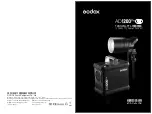
SKU 95313
For technical questions, please call 1-800-444-3353
Page 10
Return to step 4 on previous page and adjust the grinding angle to fit the teeth oriented in the op
-
posite angle. Sharpen all of these teeth following steps 5 - 14 starting on previous page. All teeth in
the chain have now been sharpened.
Turn the Power Switch to the OFF position. Remove the chain from the tool. Unplug the tool.
chainsaw chain care
There are several things you can do to prevent damage and to extend the working life of your chainsaw chain.
dulling.
The normal life-span of your chainsaw chain will vary with the quality of the chain. All
chains will dull with use, and normally can be resharpened many times. To maintain a sharp edge
as long as possible, avoid cutting into dirt or other foreign material in the wood. Dirt, sand, nails,
wire, etc. will act as abrasives rapidly dulling the chain and possibly causing additional damage to
the tool or workpiece.
Overheating.
Chains will remain sharper longer and last longer if they are not overheated. To
prevent overheating, be sure the oil reservoir on your chainsaw never runs dry, and always properly
oils the chain. Do not run the chain for a long time in one place in the wood, such as a knot or burl,
as this will cause overheating. If you observe smoke rising from the cut, lift the saw out of the work-
piece, and let it run for a few seconds in the air to cool it down.
Binding.
Chains can be damaged if they become bound in a workpiece or are twisted by the work-
piece. Always line up your cut and prop the workpiece in such a way that it will not bind the chain as
it is cut. If the chain becomes bound, stop cutting, and use a wedge to open the cut and release the
chain.
Forcing the cut.
If the chain will not easily cut the workpiece, do not force it. Forcing the cut will
result in chain overheating or binding. Sharpen your chain and try again, or use another means to
cut extremely hard material.
chainsaw sharpener Maintenance
Keep the Sharpener clean and free of dust, metal debris and dirt.
Check the Grinding Wheel before each use to make sure it isn’t damaged. Do not use a grinding
wheel if it is chipped, cracked, or worn. You can check if the wheel has cracks not visible to the hu-
man eye by hanging it up by the central hole and tapping it with a non metal object (i.e. screwdriver
handle). If it is in good condition it will produce a metallic sound. A dull sound indicates a crack or
break.
Replace the Grinding Wheel when it grinds down to a diameter of 3 inches or less.
Check the condition of the chain as you sharpen it. Twisted links must be repaired or the chain
discarded. If the chain has been sharpened repeatedly, it will eventually be worn down and must be
discarded. Never use a worn or damaged chain on any chainsaw.
15.
16.
1.
2.
3.
4.
1.
2.
3.
4.































